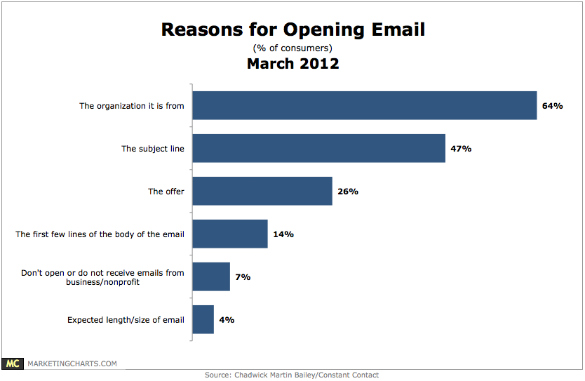The conversion rate of an email is heavily weighted by the subject line. Your prospects will look at the subject line for less than two seconds. That is about as much time as they get with a billboard on a highway. A subject has to intrigue your prospect enough that they’ll open the email. Without that intrigue, you just wasted all the time it took to write the email and put a mailing list together. Worse yet, maybe you just got unsubscribed. It is not unheard of for marketers to spend as much if not more time on the subject line than on the actual content of the email.
A/B testing subject lines is standard practice. Every email you send out should be A/B tested. Don’t work in a box –— ask your coworkers what they think of A and B versions. There are usually too many variables in your target audience to assume you know all of them. What works for one audience may not work for another, so you will have to test variations and keep a log of the open and click rates to avoid repeating yourself six months later. Here are some proven strategies to start you in the right direction.
- Subject length – The subject should be shorter than 50 characters. The reason for this is twofold: (1) The reader’s attention span is microscopic. Think in sound bites. (2) You run the risk of getting the subject line cropped in email systems. Look at your email on your phone. There are exceptions. If your audience is very targeted and/or has a high open rate, then you can have a longer subject line; just keep the pertinent information in the first 50 characters. In the days of print the best headlines lines were three to five words and the limit was eight words.
- Numbers – People like quick facts and fast wins. This is why subject lines with numbers such as “3 Ways to Save Time at Work” have a higher open rate than “How to Save Time at Work.”
- Capitalize – As with online text ads, you can get higher conversions with the first letter of each word capitalized. Capitalizing one word also works.
- Negative or positive message – This is a sad commentary on our society, but people open messages with negative subject lines more often than they do positive ones. I guess that is why tabloids do so well in the supermarket. Here is an example: “3 Ways to Improve Your Speaking Skills,” compared with “3 Things Not to Say When Speaking Publicly.”
- Don’t pitch – Keep the subject to the point, direct, and not splashy or too promotional. Subject lines about coupons, discounts, and sales often don’t do well unless they are highly targeted. The subject line should tell what is in the email; it should not be a sales pitch about what is in the email or a pitch about the product or service.
- Ask a question – Stopping your reader to think about something that affects them is a classic sales technique. Think about the problems they are solving or obstacles they need to work around. Then try asking a question that gets their attention and, that gets them thinking about something that would benefit them.
- “From” line – The email should come directly from you or another human. “donotreply@…” or “sales@…” is a sure way to lose confidence and trust. It also does not build a personal connection. People prefer to buy from people, not machines.
- Company name – Having your company name in every email builds trust and brand identity and makes emails easily searchable for the reader.
- Humor – People love a good laugh or a play on words bringing levity to the day. Just make sure it is not offensive, or it can backfire.
- Testing on Twitter – Test your subject lines on Twitter. Send out tweets with different subject lines and see which ones get retweeted or mentioned more often. You can even ask which they like better. For blog posts you can post the blog and measure click through rate of the link on the tweet for each subject line.
Following these tips will improve your email open rates, and using an email platform or email software like Constant Contact will provide the data and analytics about how your email campaign is performing.
- The Rise of Intelligent Websites - February 19, 2025
- Top Trending Products to Boost Your Shopify Store in 2024 - September 4, 2024
- AI Terms Glossary: Key AI Concepts You Should Know - August 22, 2024


